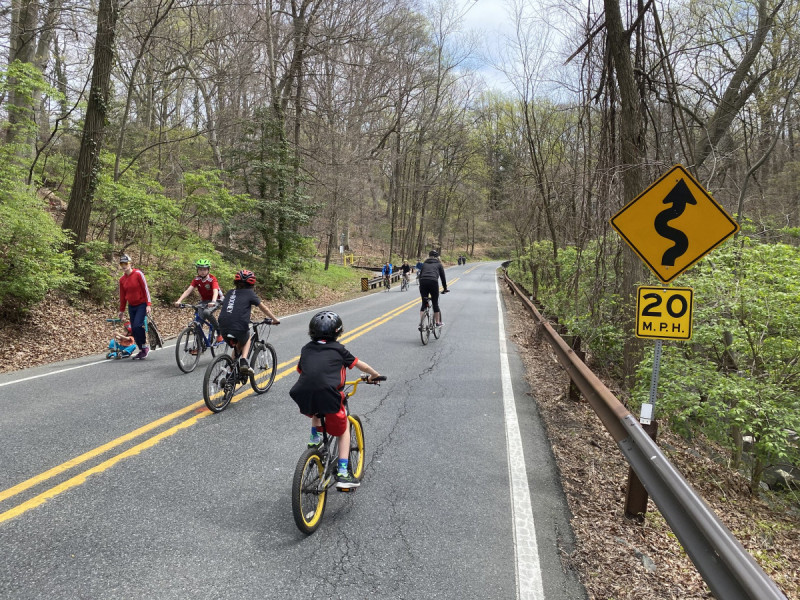Advocates push for 19 additional miles of shared streets in Montgomery County

Family of bikes on Sligo Creek Parkway by Dan Reed licensed under Creative Commons.
This is the second article in our exploration of suburban open streets. You can read the first article here.
The success of opening streets to walking and biking in Montgomery County has shown that jurisdictions don’t need to be urban or have a perfect street grid. The shared streets approach allows for us to prioritize pedestrians and cyclists while still allowing local traffic.
At the same time, the open streets experiment shows that walkable, transit-oriented neighborhoods are uniquely adaptable to changing needs and are continuously vibrant despite the circumstances. Although many still think of Montgomery County as a suburban jurisdiction, there are plenty of areas — even outside of the urban centers of Silver Spring and Bethesda — that are prime contenders for re-imagining how we use our streets.
Of course, streets are for more than recreation
Right now, it’s especially important that people can get to their destinations safely. Although a growing body of research points to public transit not playing a role in COVID-19 transmission, it can be expected that ridership will be slow to return to pre-pandemic levels, whether due to unfounded fear or increased telecommuting.
WMATA officials have also noted that getting the large Metro train and bus systems up to full, pre-COVID running status will be logistically challenging for many reasons. The transit authority made the decision to drastically cut service in March, shuttering 19 Metro stations completely. Officials say bringing more trains back online, opening stations, and instituting new cleaning regimes may mean that the system won’t be fully operational until sometime in 2021.
Likewise, MCDOT has said that it will take a minimum of two months to get Ride-On bus system back up to regular, full-run status, in part because they are prioritizing the health and safety of the drivers. Officials have also said several times this summer that they will be watching to see how changes in telecommuting will impact commuter patterns and needs for transit in the long-term.
“COVID” 19 miles of shared streets
Rather than an explosion in personal vehicle use, advocates hope to promote active ways of moving around: walking, rolling, and biking. This may also be the ideal time to promote bikes as tools for transportation rather than strictly as toys or recreational items.
A group of four organizations (Action Committee for Transit, Forest Estates Community Association, Washington Area Bicycle Association, and the Coalition for Smarter Growth) are calling on Maryland’s State Highway Administration (SHA) to implement 19 miles of shared streets to “promote greater connectivity of bicyclists and pedestrians, and make it safer for those who do not want to drive or do not have access to a car to make through Montgomery County.”
1. University Blvd/MD-193 from Colesville Road/MD-29 to Veirs Mill Road/Md-586 (3.0 mi)
2. Veirs Mill Road/MD-586 from MD-193 to Matthew Henson Trail (2.7 mi)
3. Frederick Road/MD-355 from Germantown Road/Md-118 to Middlebrook Road (.8 mi)
4. Piney Branch Road/MD-320 from Sligo Creek Pkwy to New Hampshire Ave/MD-650 (1.4 mi)
5. Old Georgetown Road/MD-187 from I-495 to Executive Blvd (2.6 mi)
6. Georgia Ave/MD-97 from Norbeck Road/MD-28 to Olney Sandy Spring Road/MD-108 (3.5 mi)
7. Georgia Avenue/MD-97 & 16th Street/MD-390 from I-495 Overpass to Colesville Road (1.5 mi)
8. East-West Highway/MD-410 from Georgia Ave/MD-97 to Connecticut Ave/MD-185 (3.2 mi)
The time is now
Before the pandemic, traffic engineers often said traffic was always too intense to try anything that might risk delaying vehicle travel times by a few seconds. Currently, traffic is still low while many people are staying inside and working from home; yet, advocates have heard from transit agencies that because traffic is so low, nothing needs to be done to prioritize non-auto travel modes. The time is now.
As we move into the next phase of open streets, public officials and advocates especially need to take equity into consideration. This includes geographic equity to ensure that neighborhoods of varying demographic makeup have streets that fit their needs. They also need to consider enforcement — our streets should be places where everyone feels safe and is free from harm.
Now is the time to question whether our streets are meeting our recreational, mental health, safety, economic, and transportation needs. It’s not just a question for downtowns, but a question for everywhere.
